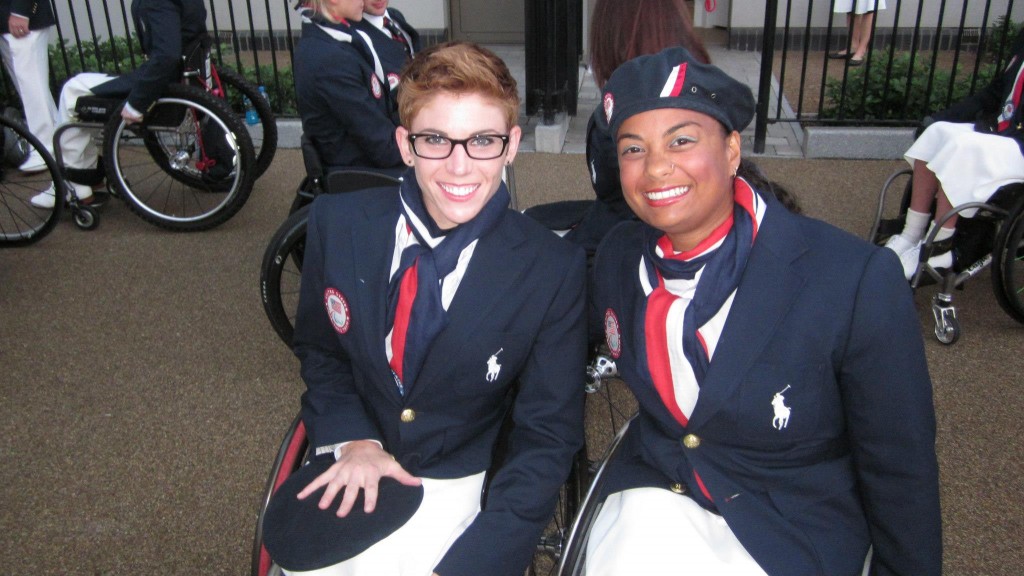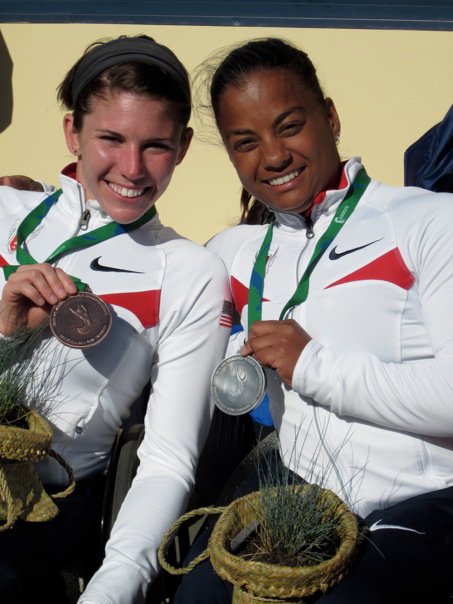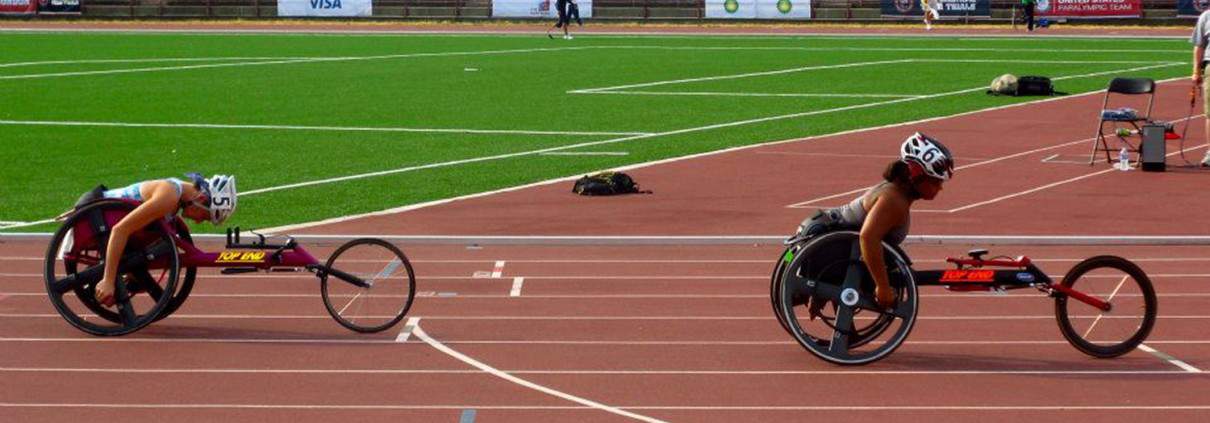The Spinal Fusion Experience
– Amanda McGrory and Dr. Anjali Forber-Pratt
Paralympian medalists Amanda McGrory and Anjali Forber-Pratt were diagnosed with transverse myelitis at a young age. Dr. Anjali Forber-Pratt is a member of SRNA Board of Directors.
Spinal fusion surgery is something we’ve been hearing a lot of parents talk about, and we would like to share our stories and perspective. Spinal fusion rod surgery is fairly normal for any child growing up using a wheelchair (due to SCI, spina bifida, TM among many others). Developing scoliosis and at some point needing rods is just part of our developmental trajectory and it is not something to feel totally blindsided by. Your child can, and will, lead a very active healthy life post-surgery. Yes, it is a major surgery, and with any surgery there are risks and so forth, but we hope that by sharing our stories it will be a helpful perspective for all to consider.
Amanda: I was admitted to A.I. duPont Institute in July of 2000 for a full spinal fusion – stainless steel rods beginning at T1, and running all the way down my spine where they finally anchored into my pelvis. As a 14-year-old competitive wheelchair racer and basketball player, I was pretty sure my athletic career and dreams to compete at the Paralympic Games were going to be left on the table in the operating room.
Anjali: I was scheduled for my spinal fusion in November 2000, and we had medically put off this surgery until the last possible moment. My curve was 120 degrees and I was not sleeping at night due to pain. The original surgical plan was to have top to bottom rods the whole way down my back. Unfortunately, days before my scheduled surgery my surgeon had a heart attack and died, so I had to quickly find a new hospital, new surgeon and start the process over again. I was fortunate to be quickly established with an orthopedic surgeon at Boston Children’s Hospital and this new surgeon was extremely reluctant to do any type of rod surgery on me, and ended up proposing an entirely different surgical approach which was to fuse only the worst of my curve from T11-L4 in the middle of my back and to leave both my upper and lower curve as is.
Amanda: I was diagnosed with transverse myelitis when I was five years old in October of 1991. Scoliosis was a concern for my doctors from the start. Although my sensory level fell between L1 and L2, my motor function declined steeply at T9 – without those strong core muscles, my doctors feared that as I neared puberty, I wouldn’t be able to properly support my quickly growing body, and they were right.
Anjali: I got sick with TM as a baby at T10, at 4.5 months old in November of 1984. My parents always knew that scoliosis was going to be an issue because I was so young and developmentally still growing without the benefits of a strong core and the ability to properly engage those muscles. It was always told that sometime after puberty when most of my growing was done, I would need rod surgery.
Amanda: Over the course of 6 months, my curve increased from single digits to over 50 degrees, in an “S” shape – I had no pain, but the top part of my curve was putting pressure on my heart and lungs. My general practitioner immediately recommended I see an orthopedic surgeon, who in turn immediately recommended I have surgery to correct the curve. “The sooner we do the operation,” they told me, “the better the chance we can fully correct the scoliosis and minimize the damage to your internal organs.”
Anjali: My new surgeon spent over an hour with me having me get up off the ground, roll over, open a door, push my wheelchair etc. He was watching and saw that I actually used my curve to be able to increase my functional abilities. I adapted to my curve and had pretty remarkable balance considering how skewed my x-rays looked. My orthopedic surgeon was also highly concerned that my active lifestyle, which involved wheelchair racing, swimming, tennis, basketball, skiing etc. would be greatly compromised by this surgery. The doctor told me I would lose flexibility in my back, have to relearn how to balance and sit and do all of these things, and that there was no guarantee that the movements that I was reliant on to be a competitive ski racer would be the same. However, at this point, my pain was unbearable and there was growing concern that my organs were going to be crushed soon if we did not intervene.
Amanda: Both my parents and myself were hesitant to schedule the surgery right away. I had qualified to compete at the 2000 National Junior Disability Championships (NJDC), and because no one could give us a definite answer on whether or not I’d be able to continue competing after the fusion, we decided to push the surgery back a few months until after the competition.
Talking to other athletes at the NJDC about spinal fusions, I learned that everyone had a different experience – some recovered immediately, some went through a lengthy rehab program, some felt stronger and gained function, others lost balance and stability. What I took away from those conversations is that just like disabilities, there is no universal experience, no universal diagnosis, no one right answer. It varies from person to person, and it’s most important to make the best choice for your own unique body.
Anjali: Growing up with other families of kids with disabilities who were active and involved in sport was a blessing. At NJDC and in my home community too, I also learned quickly that everybody’s medical experience and process of going through the fusion surgery itself and the recovery was different. But, the thing I learned most was that this surgery was inevitable, and it was not coming about because of anything I did wrong, not because of anything that my parents should have done differently, and not because I didn’t work hard enough at strengthening my muscles. This just is a normal process that all kids growing up with spinal cord disabilities have to go through. My parents had a hard time with it too – I was constantly harped on for not sitting up straight, for sleeping in a ball, for leaning to the left when watching television, but the truth of the matter is, growing in combination with weak muscles from TM, these issues were bound to happen. It is nothing that you as parents, or you as kids with TM are doing wrong.

Amanda: Speaking with my surgeon after the competition, he presented me with a few different options. The biggest, of course, was the length of the rods to be put in. Shorter rods would result in fewer changes to my body – they wouldn’t be attached to my pelvis, so my balance wouldn’t really be affected, but with them, it would be impossible to fully correct my curve, and I would most likely need to have a second fusion when I was older after my body finished growing. Longer rods could affect my ability to compete, as I would lose the use of most of my core muscles, but the chance of needing to return for a secondary operation was very slim. My parents let me make the decision on my own, and in the end I chose to go for the full fusion – T1 to my pelvis. The idea of returning for an almost guaranteed secondary surgery after a few years more of competitive athletics sounded much worse to me than just diving in all at once.
Anjali: For me, I trusted my surgeon who was proposing the alternate surgery of fusing only the worst part of my curve knowing that this would buy me about 10 years of competition and that I would likely need to have my rods lengthened to address the lower part of my curve and anchor into my pelvis at a later date.
Amanda: The surgery itself went very well. The rods were inserted, screwed into my pelvis, attached to my spine with twisty ties (seriously), and the spaces between were filled with powdered cadaver bone. I spent three days in the ICU, three days on the rehab floor, and was then sent home. I remember the incision being painful and having difficulty transferring and sitting upright for the first couple weeks, but I healed quickly. In fact, the day I was released from the hospital, my family and I drove to Maryland for a weekend at the beach. To be completely honest, I mostly stayed inside and played Nintendo between naps, but still).
Anjali: This was one heck of a long surgery. I believe I was under for 11+ hours, as when they got in they found blood vessels in places that didn’t belong so it took them a lot longer to clean that all up before placing the rods and screws. Then, after the fusion part was done (they took bone from my rib), they were getting ready to wake me back up and gave me IV dose of pain medicine and I flat-lined due to anaphylactic reaction to the medication. Needless to say, this earned me a first class ticket to the ICU where I stayed for several days. When I eventually woke up, the first thing I did was punch a nurse (in my defense, they did kill me!) so I woke up in a 5-point restraint, still intubated and quite swollen from the whole affair. I moved to a regular hospital room and had pretty strict precautions on what I could and could not do.
Amanda: I had one small setback during recovery with a minor infection in the incision, but everything was fully healed and my staples were removed in time for me to begin 9th grade. I was told to wait a few months before returning to sports, just to be sure that the fusion was healed enough to handle the stress and impact. I began playing basketball again in the fall, and racing that spring.
Anjali: Because of the surgical approach used and that there was no strong anchor point for the rods, I was not allowed to make any unassisted transfers for 6 months after surgery. I was not allowed to lift anything heavier than a one-subject notebook and I was not supposed to push up ramps/curb cuts without assistance. I did not have a brace after the surgery, but had to obey the precautions so that the fusion would “take”. I grew 7” in one day from this surgery! As a short person, this was highly exciting for me. But, I did have symptoms of vertigo because of this, and I had trouble eating food off of my plate because the food felt too far away from my brain, and things like the location of door knobs were weird for my brain to interpret for a couple months because of this instant growth. I was able to learn ways to safely return to self-transferring as long as my legs were supported, once I reached about the 3-month mark. I was lucky that at my 6-month appointment, I was fully healed and allowed to return to all activities with no restrictions at that point. While my doctor did take a very conservative approach to this recovery, I understood why these precautions needed to be in place.
Amanda: The doctors were right in assuming that my balance would be affected by the rods, but it in no way affected my ability to be competitive in sports. In both basketball and track, my classification was adjusted to reflect my slightly wobblier status – from a 2.0 to a 1.0 in basketball, and a T54 to a T53 for track. I continued with both sports through high school, and attended the University of Illinois on a wheelchair basketball scholarship. I stopped playing basketball after I graduated, but I am currently a member of the US Paralympic Team for track and road racing, and a four time Paralympic medalist.
Anjali: My balance was greatly affected by this surgery, as was predicted. My classifications for sports did not change, as I was already a T53 in track and LW10 in skiing. I went on, as many of you know, to make my first national team for wheelchair racing in 2007 and competed in the Beijing and London Paralympic Games and I am a two-time medalist.

Just prior to the London 2012 games, I started having lower back pain and problems, which was almost like clockwork, 11 years after my initial fusion. I worked with my doctors to put a plan in place to delay the inevitable rod lengthening surgery so that I could still compete in the London Games. I went in for surgery 10 days after the games to have my rods lengthened L4-S1. The surgery itself went fine, but post-surgery I began having life-threatening complications and did in fact code a week after surgery. I spent a month in the hospital and for four weeks there was nothing but questions and very little answers about what was going on. I only knew that something wasn’t right. This additional fusion exacerbated issues due to a tethered spinal cord that we didn’t know I had until this fusion revision. I have had multiple surgeries since then to correct the untethering surgery (May 2013), had another spinal fusion revision (October 2014) and most recently have had a trial and permanent spinal cord stimulator placed (June 2015) to help with pain management.
Amanda: I have never, in any way, regretted my decision. The full spinal fusion was definitely the right choice for me and I’m glad I was able to weigh my options and make the decision for myself. It, like any surgery, was scary – both for myself and my parents, but I feel confident that my quality of life now is much higher than it would be had I not gone through with the operation.
Anjali: My story has unfolded with more complications than Amanda’s, but I have never regretted my initial decision to take the risk on the partial fusion surgery. I was able to be a normal kid and experience the joy of sport and thrill of competition in between my two surgeries. I also do not regret going in for the fusion revision in 2012; it was the best decision for me at the time. I was able to make informed decisions on what path to take. I fully believe that it was a perfect storm of sorts and that none of these complications could have been predicted or avoided and while I wish that I hadn’t had all these recent complications and issues, I am confident that I am now on a path to a greater quality of life and healthier living. I certainly do wish that my athletic career had not been halted due to these medical issues, but I’m grateful to still be able to live independently, work and enjoy the happy moments in life.





